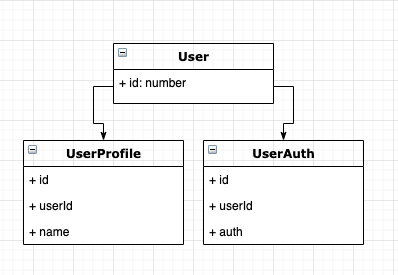
Overview
솔리다리테 백엔드에서 Nest.js와 TypeORM를 애용하는 편입니다. 두 라이브러리 모두 독스의 완성도가 훌륭한 편입니다. 하지만 실무에 적용하면서 여러 난관에 부딪히게 되더군요. 😃 Repository와 Service의 경계를 분리를 하고, 리팩터링하여 재사용성을 높였던 방법을 공유하고자 합니다.
Aggregate (집합체)
Aggregate는 데이터 변경의 단위로 다루는 연관 객체의 묶음이라고 합니다. 일반적으로 우리가 생각하는 비즈니스 도메인의 단위가 됩니다.
예를 들어, User 객체와, UserAuth (유저 권한), UserProfile (유저 프로필)객체를 통틀어 하나의 Aggregate라고 할 수 있습니다.

UserAuth와 UserProfile은 User에 종속적이기 때문에 UserAuth나 UserProfile은 따로 삭제되어서는 안됩니다.
하지만 Nest.js와 TypeORM을 연결해 쓰다보면 Service에서 각각 엔티티 Repo에 접근할 수 있기 때문에, 다음과 같이 UserAuth만 지워질 위험이 있습니다.
@Injectable()
export class UserService {
constructor(
@InjectRepository(User)
private readonly userRepository: Repository<User>,
@InjectRepository(UserAuth)
private readonly userAuthRepository: Repository<UserAuth>,
@InjectRepository(UserProfile)
private readonly userProfileRepository: Repository<UserProfile>,
) {}
public async deleteUserAuth(
userAuthId: number
) {
await this.userAuthRepository.delete(userAuthId)
}
}따라서 Aggregate당 하나의 Repository를 만들어 진입점을 한 곳으로 모아 관리를 하는 경우가 일반적입니다. 위와 같은 경우에서는 UserRepository 커스텀 클래스를 만들어 객체 접근에 관한 설계를 결정합니다.
import { AbstractRepository, EntityRepository } from 'typeorm'
import { User } from './user.entity'
export interface UserFindOneOptions {
id?: number
}
@EntityRepository(User)
export class UserRepository extends AbstractRepository<User> {
// userAuth, userProfile 조회를 막고, user를 통해서만 조회 가능하도록 합니다.
public async findOne({ id }: UserFindOneOptions = {}) {
const qb = this.repository
.createQueryBuilder('User')
.leftJoinAndSelect('User.userAuth', 'userAuth')
.leftJoinAndSelect('User.userProfile', 'userProfile')
if (id) qb.andWhere('User.id = :id', { id })
return qb.getOne()
}
public async delete(userId: number) {
return this.repository.delete(userId)
}
}UserRepository를 커스텀하여 의도치않은 접근을 모두 막았습니다. 이제 userService 에서 각각의 Entity에 따로 Repo를 접근하지 않고 Root 객체인 User에만 접근하여 나머지 하위 객체를 조회할 수 있습니다.
import { Injectable } from '@nestjs/common'
import { UserRepository } from './user.repository'
@Injectable()
export class UserService {
constructor(private readonly userRepository: UserRepository) {}
public async findByUserId(userId: number) {
const user = await this.userRepository.findOne({ id: userId })
// user.userAuth or user.userProfile 접근 가능!
return user
}
public async delete(userId: number) {
// DB Cascade를 걸어주어 userAuth와 userProfile까지 삭제되게 한다.
return this.userRepository.delete(userId)
}
}커스텀 Repository를 만들어 다음과 같은 효용을 누릴 수 있었습니다.
- Aggregate의 경계와 Repository의 역할 범위를 일치시킴
- Repository의 개수를 줄임
- 불필요한 또는 위험한 접근을 차단
다음 포스트에서는 TypeORM 쿼리 빌더의 재사용성을 높이는 방법에 대해 알아보겠습니다.

안녕하세요 글 잘 읽었습니다. 감사합니다.
DDD라는 것을 이제 막 접한 코린이 입니다.
한가지 궁금한 점이 있는데요
userAuth와 userInfo를 leftJoinAndSelect 하셨는데 이는 userAuth 테이블과 userInfo 테이블이 따로 존재하는 것으로 봐도 무방할까요 ?